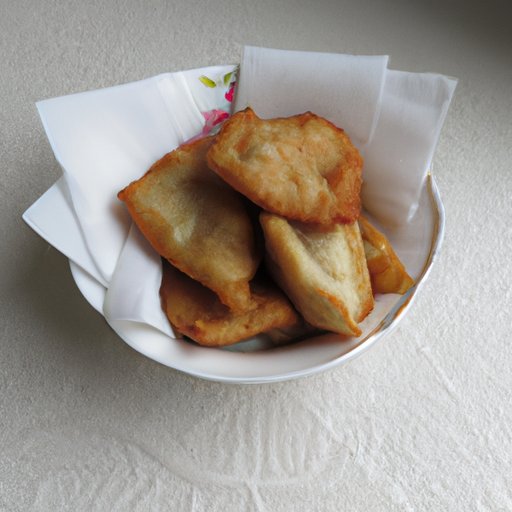
Introduction
Potato cakes are a versatile and delicious recipe that have been enjoyed by families for generations around the world. Whether baked, fried, or grilled, they are guaranteed to satisfy even the most complex of cravings. Not only are they tasty, but potato cakes are also filling, making them an excellent choice for any meal of the day, from breakfast to dinner, and even as a snack.
With this article, we aim to provide our readers with a comprehensive guide to making potato cakes that will inspire them to try out the recipe and experiment with their own variations. We have also gathered historical, nutritional, seasonal, and travel-inspired variations that will challenge them to take on new culinary adventures.
How to Make Potato Cakes
To make potato cakes, you will need the following ingredients: potatoes, flour, butter, egg, salt, and pepper. You can also add additional spices, herbs, or cheese to customize the recipe to your desired taste.
In a large mixing bowl, boil the potatoes until they are soft and cooked through. Mash the potatoes with a fork or potato masher and set aside to cool. Add the flour, melted butter, egg, salt, and pepper, and mix well until combined. Form the mixture into round patties or flatten them out if you want to create more of a traditional cake shape.
Preheat a lightly oiled skillet over medium heat. Once it is heated, add the patties or cakes and cook for 2-3 minutes on each side or until they are golden brown and crispy.
The trick to perfecting these cakes is to ensure the consistency of the mixture: not too sticky or too dry. Also, make sure not to overcrowd the skillet to avoid the cakes from sticking and to achieve the desired texture.
For some extra flavours, try adding chopped scallions, chives, or parsley into the mix, providing an additional dimension of texture and flavor to your cakes.
History and Origins of Potato Cakes
Potato cakes, also known as potato pancakes, are a popular dish that hails from many parts of the world, each with their unique variations and cultural ties.
A Scottish variation of potato pancake is called Tattie Scones, which uses mashed potatoes, flour, and salt. This variation is often served at breakfast, accompanied by eggs and bacon. Meanwhile, Irish potato cakes, also known as Boxty, are made from grated, raw potatoes mixed with flour and milk or buttermilk. They are usually cooked until crispy on the outside and served with a variety of toppings, such as sour cream or smoked salmon.
The Swiss recipe for Rosti is made from grated potatoes shaped into a patty, then fried until crisp. Fried potato cakes originated in Eastern Europe and were a way of using up leftovers. This is perhaps why they remain popular to this day.
Nutritional Information on Potato Cakes
Apart from being an enjoyable dish, potato cakes are also a rich source of vitamins, minerals, and carbohydrates that the body requires to function optimally. One large potato can provide around 46 grams of carbohydrates and is also rich in fiber, vitamin C, and vitamin B6.
The flour component provides additional nutrients such as zinc, niacin, thiamine, and iron, depending on the type of flour used. While it isn’t the most nutritious ingredient in the recipe, it does provide the necessary structure for these cakes.
To make the recipe more healthful, try adding other vegetables like shredded zucchini, carrots, or sweet potatoes for additional flavor and nutrients. You can replace wheat flour with almond, rice, or coconut flour to reduce the recipe’s gluten content. The potato cakes can also be baked instead of fried, reducing the oil used.
Seasonal Variations on Potato Cakes
Potato cakes can be enjoyed throughout the year with different accompaniments, depending on the season and your preference. During the summer months, they can be paired with fresh salads such as coleslaw or cucumber salad. During the fall, potato cakes can be served with sour cream or applesauce. In winter, they can be paired with roasted root vegetables, and during spring, potato cakes with a side of sautéed asparagus or kale gives the dish more color and flavor.
The delicious variations for potato cakes can be endless once you find the right seasonal combinations that will keep you satisfied throughout the year.
Travel-Inspired Potato Cakes
Experience global flavors by trying out different variations of potato cakes. A Korean variation of the cakes, called Gamjajeon, is made with grated potatoes, onions, and green onions, fried to golden-brown perfection, and served with a soy sauce-based dipping sauce. Another variation, the Indian Aloo Tikki, is made from mashed potatoes mixed with chickpea flour and spices, then deep-fried until crispy and served with tamarind sauce.
These international recipe variations are entirely worth trying out and can add an interesting historical and cultural texture to your potato cakes. They are easy to assemble with readily available ingredients and straightforward to prepare.
Conclusion
Whether you are an experienced cook or a beginner in the kitchen, potato cakes are an excellent recipe to challenge both your culinary skills and your taste buds. By following our step-by-step guide and exploring the different variations of the recipe, you can create a dish that is customized according to your preferences.
With the historical, nutritional, seasonal, and travel-inspired variations we have explored, readers can try new recipes, explore different cultures and histories, and utilize nutritious ingredients creatively. We hope this guide has encouraged you to try making potato cakes and explore their versatility further.




